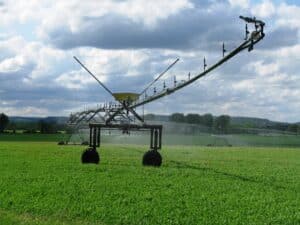
AgroLiquid has several facilities across the United States for manufacturing, distribution, and research. The first one we’re going to feature is in Ashley, Michigan. The Ashley facility is a manufacturing and distribution center for the company’s liquid plant nutrition products.
- Opened: 2011
- Acres: 14
- Staff: 15
The facility, managed by Tom Hoten since 2011, is a manufacturing and distribution center that helps AgroLiquid deliver high-quality plant nutrition.
Manufacturing and research
The Ashley facility is also the birthplace of new ideas and products for the entire company.
“The research and development products are made here,” Tom said. “We then send them out to various locations throughout the country.”
Once manufactured and tested, the final products are shipped out to the dealer network in a variety of sizes to meet every customer’s need.
“For example, everything leaves here as a liquid in 2.5-gallon container, 275-gallon cage tote, semi-tanker, or a rail car,” he said.
Every season has different challenges, like recognizing the right indicators to make decisions to help stay in front of demand curves. Weather is always a big factor, and it involves paying attention to what’s going on in the regions, and this helps decide where to heavily apply resources, and where to pull back. For the facility leaders, it’s a lot of constantly observing, tweaking, and making decisions along the way.
“It’s challenging but fun, and that’s what I like about it,” Tom said. “It’s never monotonous. It’s the same task, but you have to go about it differently to be successful at it.”
Efficient
The entire operation is powered by 15 people. According to Tom, this structure is by design.
“We run a pretty lean crew,” he said. “It’s intentional because of the seasonality of the business – spring is the busiest, late summer is the slowest, and this way it works well. We’re very efficient.”
This efficiency depends on communication and versatility. The Ashley team uses a collaborative and all-hands-on-deck approach.
“It requires a lot of communication because there’s a lot of moving parts with the day-to-day operation,” Tom said. “Everyone knows how to do everything here so when someone is sick or takes time off, someone can just slide over and pick up the slack.”
Growth
Since 2011, the facility has seen significant growth. For instance, last year they added one million more gallons of storage to the facility. As for infrastructure, they plan on updating and upgrading their fleet. They do all their own transportation and work to meet customer demand and needs with fresh, current, and clean trucks.
Looking ahead, their goal is to continue to perform at a high level, evaluate current processes, and see if they fit their needs as a growing company.
“What might fit today might not tomorrow,” Tom said. “We’re focusing on continuous improvement, making sure we have the right people in the right places, and making sure everyone has the right resources to be successful.”
Ultimately, the success of the Ashley facility comes down to its people, and Tom likes the way his team works together.
“I’m proud of my team’s commitment to the company,” he said. “They step up to the tasks and make things happen.”





 Think of your soil’s cation exchange capacity as a parking lot for nutrients. Every parking spot represents a site where cations – like potassium, calcium, magnesium, hydrogen, and sodium – can attach. While a high CEC shows many available parking spots, it’s the percent base saturation that tells us who is actually parked in those spots, and in what proportions.
Think of your soil’s cation exchange capacity as a parking lot for nutrients. Every parking spot represents a site where cations – like potassium, calcium, magnesium, hydrogen, and sodium – can attach. While a high CEC shows many available parking spots, it’s the percent base saturation that tells us who is actually parked in those spots, and in what proportions.
